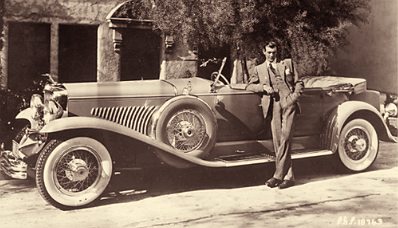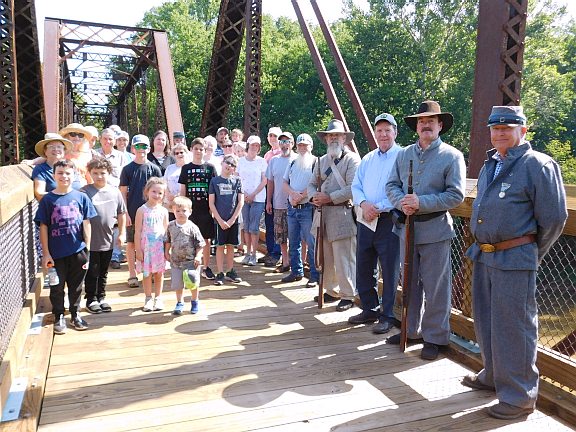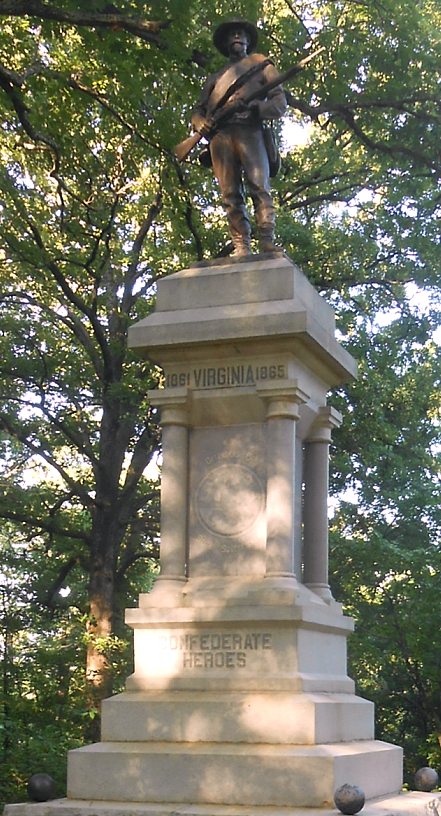This is the fifth essay in an occasional series. Previously: Part 1, Part 2, Part 3, Part 4
Requiem for a Culture
Part 5: The Graves of the Ancestors
The past is never dead. It’s not even past.
— William Faulkner, Requiem for a Nun, Act I, Scene III (page 80 in the Vintage paperback edition)
On a cold rainy Saturday afternoon back in February I drove down a long driveway between rows of ancient English boxwoods to a farmhouse in Amelia County. The occasion was the swearing-in of three new members of the Sons of Confederate Veterans at the grave of their common ancestor. It was a ceremony I felt privileged to attend.
I got out of the car into a very cold rain. The temperature was about 37°F (3°C), and the water that was coming down could just as easily have been snow if it had felt so inclined. When I approached a group of my fellow SCV members, most of them in uniform, one of them must have noticed that I was wearing only a tweed jacket. He said: “You’re gonna get wet — better go get an umbrella.”
As it happened, there was an umbrella in the car. It was one of Dymphna’s — bright yellow with a duck’s head for a handle. I went back to get it, and when I returned to the Confederates, they chuckled as they saw it. I said: “Now the Yankees can see me coming.”
Some of the members of the candidates’ families were also carrying umbrellas, but the uniformed guys just had their kepis and big floppy hats to keep off the rain. After we stood there for a few minutes, a fellow arrived with a pop-up canopy and set it up. Everyone without an umbrella crowded together under the canopy, and we all waited to see if the rain would abate so that the graveside ceremony could take place.
While we waited there was a general conversation about the event, and the history of the place where we were standing. The ancestor of the men who were being sworn in was one of eight brothers who served in the Confederate Army during the Recent Unpleasantness. Seven of the eight survived the war, which was pretty amazing. Some of the descendants had moved away, but many still lived in the area, and a good number of those had gathered in the rain to see their relatives sworn in.
The nearby house was built in the 1730s, if I remember rightly. It wasn’t one of those big antebellum mansions, but rather a modest residence, smaller than Schloss Bodissey (which is not large). But you could tell it was very old, by the shape of the chimney and by the steepness of the gables. And the land it was built on was a Crown grant.
While we waited, the various cousins caught up on the news with each other and shared family stories. It was fascinating to hear some of the accounts of the history of the place. Like most SCV members, the men were interested in history, and had read some of it, but what they were sharing were family memories handed down from events that had occurred 160 years ago, rather than stories read in books. For an outlander like myself, it was a real treat to listen in on the very local history of Amelia County.
In early April of 1865, after the siege of Petersburg had been broken, General Robert E. Lee led the Army of Northern Virginia on a retreat that passed through Chesterfield, Amelia, Nottoway, and Prince Edward counties before it ended with the Confederate naqba in Appomattox. As I understand it, General Lee camped overnight in Amelia Court House, and then continued westward the next day. The women, children, and old men in the neighborhood must have lined the road on both sides just to see the great general ride by on Traveller. The memory of that occasion was passed down through the generations alongside the soldiers’ stories of combat and suffering.
One of the seven brothers who survived the war was captured by the Union and held for more than a year at the Point Lookout prisoner of war camp in St. Mary’s County in southern Maryland. The Confederate prisoners were allowed out once a day to gather firewood. They were permitted to cut only as much wood as they could carry in their arms — no wagons or carts — and had to travel on foot to and from the place it was cut. By the time the war ended, all the trees near the camp had long since been cut, and the prisoners had to walk four miles (six kilometers) to collect their wood — four miles there, then four miles back carrying the wood in their arms. And that amount of wood had to serve for cooking and warmth for a 24-hour period.
While we were standing there in the cold, cold rain listening to these stories, I was thinking about those Confederates, both the prisoners in Maryland and the soldiers camped in the trenches outside Petersburg, in February of 1865, one hundred and fifty-eight years earlier. I was shivering, and my hands were going numb, and my jacket and pants had gotten wet despite the umbrella, but I thought: This is NOTHING. What I have at this moment is absolute luxury, compared to what those soldiers endured every single day.
Later, when I was talking to some of the other SCV members, they said more or less the same thing. We had all thought about what our ancestors had had to go through, and we all appreciated the good fortune of our own circumstances.
Listening to the stories, I learned about something I hadn’t heard of before. Almost all able-bodied men between the ages of sixteen and fifty had left their homes to defend the Commonwealth of Virginia, leaving behind women, boys, and old men (and slaves, if they had any) to tend the farm. When a unit was not facing any imminent combat during planting or harvest time, sometimes a soldier would take time off and return home to help put the seed in the ground or get in a crop. When the job was done, he would rejoin his unit.
Such soldiers were AWOL, and under the code of military justice could be dealt with harshly when they returned. One of the eight brothers had returned to the farm to get the crop in, and when he returned to his unit his superior told the commander: “So-and-so has come back. What should I do with him?” The commander replied: “Nothing. He’s too good a soldier to punish.”
Apparently that response was a common one in the Confederate Army during the war, so that it became a catchphrase afterwards: “He was too good a soldier to punish.”
* * * * * * * * * * * * * * *
After about 45 minutes of telling and listening to stories, the rain finally slacked off to a drizzle, and the general consensus was that the ceremony could proceed. We filed down the lane to the family cemetery — which was also surrounded by gigantic boxwoods — and gathered around the grave of the ancestor, who had died in 1909, while the Commander welcomed the inductees to the camp, and the chaplain administered the pledge required of new members of the Sons of Confederate Veterans.
Continue reading →



 When I got up this morning I discovered that both voice and the Internet had gone out sometime during the night. I don’t own a cell phone, and even if I did, there is no coverage out here in the Far Outback. So I just hung around, watching episodes of Firefly and waiting for service to return.
When I got up this morning I discovered that both voice and the Internet had gone out sometime during the night. I don’t own a cell phone, and even if I did, there is no coverage out here in the Far Outback. So I just hung around, watching episodes of Firefly and waiting for service to return.











 I went to the retinal specialist’s office this afternoon to get the latest in a series of periodic injections in my left eye, to treat the chronic condition of wet macular degeneration. As a result, my blogging activities will be somewhat subdued this evening. However, I expect to get at least one additional post up before I do the news feed.
I went to the retinal specialist’s office this afternoon to get the latest in a series of periodic injections in my left eye, to treat the chronic condition of wet macular degeneration. As a result, my blogging activities will be somewhat subdued this evening. However, I expect to get at least one additional post up before I do the news feed.


